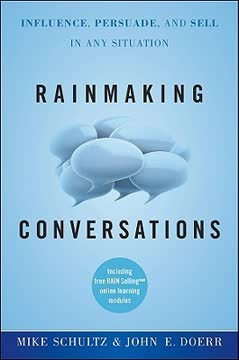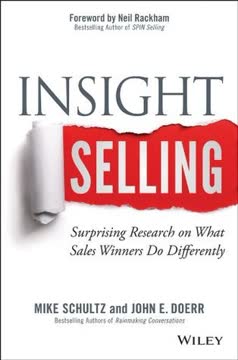Key Takeaways
1. Master the RAIN selling framework to lead successful sales conversations
RAIN is an acronym for Rapport, Aspirations and Afflictions, Impact, and New Reality.
Build rapport: Establish a genuine connection with prospects by being warm, friendly, and showing genuine interest. This sets the foundation for trust and a strong relationship.
Uncover needs: Explore both aspirations (future goals) and afflictions (current problems) to understand the full scope of the prospect's situation. Use open-ended questions and active listening to gather comprehensive information.
Demonstrate impact: Quantify and communicate the tangible benefits of addressing the prospect's needs. Use financial and emotional impact to create urgency and desire for your solution.
Paint the new reality: Clearly describe how the prospect's world will change after implementing your solution. Use visuals, case studies, and concrete examples to make the future state vivid and compelling.
2. Uncover and address both aspirations and afflictions to create value
Uncovering aspirations and afflictions is only half the story because afflictions only focus on half—the negative half—of customer needs.
Dual buyer mindsets: Recognize that buyers are driven by both problem-solving (fixing current issues) and future-seeking (achieving goals and growth) motivations. Address both to create a comprehensive value proposition.
Uncover latent needs: Go beyond obvious problems to discover hidden opportunities for improvement. Use probing questions and share industry insights to help prospects realize needs they may not have been aware of.
Example questions:
- "What are your stretch goals for the business?"
- "What don't you know yet that you need to find out?"
- "What would it look like if a company was doing an amazing job by your standards?"
Create value gap: Help prospects see the difference between their current state and the potential future state. This gap drives desire for change and willingness to invest in your solution.
3. Demonstrate tangible impact and paint a compelling new reality
The more you can create tables, graphs, and charts to help prospects understand the value and communicate it to colleagues, the more deals you will win.
Quantify impact: Translate the benefits of your solution into concrete financial terms. Use ROI calculations, cost savings estimates, and revenue projections to make the value clear and compelling.
Visualize the future: Create a vivid picture of what life will be like after implementing your solution. Use before-and-after comparisons, process diagrams, and success stories to bring the new reality to life.
Elements of a compelling new reality:
- Improved metrics (e.g., faster cycle times, increased revenue, reduced costs)
- Enhanced processes and efficiencies
- Positive emotional outcomes (e.g., reduced stress, increased satisfaction)
- Competitive advantages gained
Differentiate and substantiate: Clearly communicate why your solution is the best option and provide evidence to support your claims. Use case studies, testimonials, and demonstrations to build credibility and trust.
4. Balance advocacy and inquiry in your sales approach
The key to talking the right amount is balancing advocacy (giving advice . . . setting the agenda . . . talking) and inquiry (asking questions . . . finding out more . . . letting the client have the air time).
Ask thoughtful questions: Use a mix of open-ended and closed-ended questions to uncover needs, understand the prospect's situation, and guide the conversation. Avoid interrogation-style questioning by balancing inquiry with insights.
Share valuable insights: Demonstrate your expertise by offering relevant information, best practices, and industry trends. Use storytelling to illustrate points and make your advice more engaging and memorable.
Effective advocacy techniques:
- Share relevant case studies and success stories
- Offer data-driven insights and industry benchmarks
- Provide thought-provoking ideas and fresh perspectives
- Make clear recommendations based on the prospect's needs
Listen actively: Pay close attention to the prospect's responses, ask follow-up questions, and summarize key points to demonstrate understanding. This builds trust and helps you tailor your solution more effectively.
5. Overcome objections by listening, understanding, and responding effectively
Objections are clear signals that you have more work to do in the selling process.
Listen fully: Resist the urge to interrupt or immediately counter objections. Give the prospect space to fully express their concerns and actively listen to understand the root of the objection.
Understand the real issue: Ask clarifying questions to uncover the true nature of the objection. Often, stated objections mask deeper concerns or misunderstandings that need to be addressed.
Respond thoughtfully: Address objections directly and honestly. Provide additional information, reframe the situation, or offer alternative solutions as appropriate. Confirm that your response has satisfied the objection before moving forward.
Five-step objection handling process:
- Listen
- Understand
- Respond
- Confirm
- Continue
6. Develop fluency in essential sales knowledge to outperform competitors
Fluency = Accuracy + Speed + Breadth and Depth of Knowledge.
Master key knowledge areas: Develop comprehensive understanding in eight essential categories: expectations, market context, customer needs, company capabilities, competition, sales strategy, post-sale delivery, and account development.
Achieve fluency: Go beyond mere accuracy to develop the ability to quickly and confidently apply your knowledge in sales conversations. Practice regularly to increase your speed and depth of recall.
Benefits of sales knowledge fluency:
- Increased credibility with prospects
- Ability to ask more insightful questions
- Faster and more effective problem-solving
- Enhanced ability to tailor solutions to specific needs
- Improved confidence in challenging situations
Continuous learning: Stay up-to-date on industry trends, customer needs, and competitive offerings. Regularly seek feedback and opportunities to expand your knowledge and skills.
7. Identify and overcome hidden weaknesses that sabotage sales success
Although what you are selling might seem straightforward to you, it's often not straightforward to buyers.
Recognize hidden weaknesses: Be aware of five common hidden weaknesses that can undermine sales success: emotional involvement, need for approval, nonsupportive buy cycle, money discomfort, and self-limiting beliefs.
Seek objective feedback: Use validated sales assessment tools and seek input from colleagues and mentors to identify your own hidden weaknesses. Be open to constructive criticism and willing to challenge your own assumptions.
Strategies for overcoming hidden weaknesses:
- Practice emotional detachment in high-pressure situations
- Focus on providing value rather than seeking approval
- Align your personal buying habits with effective selling practices
- Address money discomfort through practice and reframing
- Challenge and replace self-limiting beliefs with empowering ones
Continuous improvement: Regularly assess your performance, identify areas for growth, and take deliberate action to improve. Embrace a growth mindset and view challenges as opportunities for development.
Last updated:
FAQ
What’s Rainmaking Conversations by Mike Schultz about?
- Mastering sales conversations: The book focuses on how to influence, persuade, and sell effectively in any situation by mastering the art of sales conversations.
- RAIN Selling framework: It introduces the RAIN Selling method—Rapport, Aspirations and Afflictions, Impact, and New Reality—as a structured approach to sales.
- Comprehensive sales process: The book covers the entire sales process, including prospecting, needs discovery, handling objections, and closing, with a special emphasis on building trust and long-term relationships.
- Applicable to complex B2B sales: Schultz tailors his advice for complex sales cycles involving multiple decision-makers and nuanced buyer needs.
Why should I read Rainmaking Conversations by Mike Schultz?
- Actionable sales strategies: The book provides step-by-step guidance for developing the psychology, skills, and processes needed to win new business.
- For all sales professionals: Whether you’re a salesperson, business leader, or consultant, the tools and frameworks are designed to help you fill your pipeline and close more deals.
- Trusted and endorsed: Praised by sales experts for its integrity and practical advice, it helps readers avoid common pitfalls and improve performance.
- Become a trusted advisor: Schultz’s approach helps you move beyond being just a seller to becoming a valued partner for your clients.
What are the key takeaways from Rainmaking Conversations by Mike Schultz?
- Sales conversations are critical: Mastering conversations is the bridge between initial contact and closing deals.
- RAIN Selling method: The RAIN framework (Rapport, Aspirations and Afflictions, Impact, New Reality) is central to leading effective sales conversations.
- Principles and influence: The book outlines 10 Rainmaker Principles and 16 Principles of Influence that top salespeople use to outperform others.
- Balance advocacy and inquiry: Successful sales require a balance between sharing your expertise and asking insightful questions to uncover client needs.
What is the RAIN Selling method in Rainmaking Conversations by Mike Schultz?
- RAIN acronym explained: RAIN stands for Rapport, Aspirations and Afflictions, Impact, and New Reality, guiding the structure of every sales conversation.
- Dual meanings for A and I: "A" and "I" also represent Advocacy and Inquiry, reminding sellers to balance talking and questioning.
- Focus on influence and connection: The method emphasizes building genuine relationships, uncovering both problems and aspirations, quantifying impact, and painting a compelling new reality for clients.
- Non-linear process: The stages are flexible, allowing salespeople to move back and forth as needed during conversations.
What are the 10 Rainmaker Principles in Rainmaking Conversations by Mike Schultz?
- Mindset and behaviors: The principles include playing to win-win, living by goals, taking action, thinking buying first, being a fluent expert, creating new conversations daily, leading masterful conversations, setting the agenda, being brave, and continuous self-assessment.
- Foundation for top performance: These principles are shared by top-performing salespeople who consistently outperform average reps.
- Daily reinforcement: Schultz recommends posting these principles visibly and reviewing them daily to shape your thinking and actions.
- Focus on improvement: Continuous self-assessment and feedback are key to ongoing sales excellence.
How does Rainmaking Conversations by Mike Schultz define and emphasize Rapport in sales?
- Genuine emotional connection: Rapport is about making sincere, warm, and friendly connections, not just superficial small talk.
- Critical for buying decisions: Buyers are far more likely to purchase from people they like and trust; lack of rapport is a major deal-killer.
- Building rapport tips: Be authentic, show real interest, calibrate conversation length, read the client’s culture, and balance advocacy with inquiry.
- Active listening and storytelling: Listening actively and sharing relevant stories help build trust and deepen relationships.
What are Aspirations and Afflictions in the RAIN model, and why are they important in Rainmaking Conversations by Mike Schultz?
- Dual focus on needs: Aspirations are future goals and desires, while afflictions are current problems or pain points; both are essential to understand the client fully.
- Unlocking bigger opportunities: Focusing only on afflictions limits your sales potential; uncovering aspirations opens doors to larger, future-oriented deals.
- Guided questioning: Use a mix of open-ended and closed-ended questions to uncover both explicit and latent needs.
- Stimulate client thinking: Balancing inquiry with advocacy helps clients articulate needs they may not have considered.
How does Rainmaking Conversations by Mike Schultz explain the concept of Impact in sales conversations?
- Clarifying the “So what?”: Impact answers why solving a problem or achieving a goal matters, quantifying both financial and emotional consequences.
- Two types of impact: Rational impact includes measurable business benefits like ROI, while emotional impact addresses recognition, happiness, and stress reduction.
- Making impact tangible: Salespeople should calculate dollar values, communicate emotional benefits, and use case studies to substantiate claims.
- Building urgency: Comparing alternatives and highlighting consequences of inaction help create urgency for the buyer.
What is the New Reality concept in Rainmaking Conversations by Mike Schultz?
- Vision of success: New Reality is the future state clients will experience after buying from you, reflecting their aspirations and solved afflictions.
- Benchmarking and solution crafting: Establish a realistic new reality benchmark before proposing solutions, then communicate benefits clearly.
- Differentiation and trust: Show why your offering is the best option and build belief that you can deliver on your promises.
- Use of stories and data: Reinforce your message with stories, visuals, and quantitative data to make the new reality compelling.
What are the 16 Principles of Influence in Sales according to Rainmaking Conversations by Mike Schultz?
- Comprehensive influence framework: Principles include Attention, Curiosity, Desire, Envy, Emotional Journey, Belief, Justification, Trust, Stepping Stones, Ownership, Involvement, Desire for Inclusion, Scarcity, Likeability, Indifference, and Commitment.
- Purpose of each principle: They guide sellers in capturing attention, building trust, stoking desire, reducing risk, and creating urgency.
- Application in sales: Mastering these principles helps sellers lead buyers through both emotional and rational journeys, increasing close rates.
- Peer-to-peer dynamic: Principles like Indifference and Ownership foster a peer relationship, reducing buyer resistance.
How does Rainmaking Conversations by Mike Schultz define and use the concept of Indifference in sales?
- Emotional detachment: Indifference means being willing to walk away if the deal isn’t right, preventing desperation and neediness.
- Reversing direction: Suggesting ending talks if the buyer isn’t engaged can actually draw buyers back in or save time if they’re truly uninterested.
- Building trust and ownership: Buyers feel less pressured and more in control, which builds trust and a peer-to-peer dynamic.
- Reduces resistance: Indifference helps salespeople avoid appearing needy, which can undermine credibility and influence.
What is the FAINT qualification method in Rainmaking Conversations by Mike Schultz, and how does it differ from BANT?
- FAINT explained: FAINT stands for Financial Capacity, Authority, Interest, Need, and Timing, and is designed for complex, unplanned purchases.
- Focus on capacity, not budget: Unlike BANT, which emphasizes budget, FAINT recognizes that many buyers have the capacity to buy even without a set budget.
- Comprehensive qualification: FAINT ensures you engage with buyers who have decision authority, genuine interest, real needs, and a timeline for purchase.
- Increases closing chances: By focusing on capacity and willingness, FAINT helps salespeople prioritize prospects who are more likely to buy.
What are the best prospecting strategies in Rainmaking Conversations by Mike Schultz for demand-driving and demand-driven offerings?
- Demand-driven prospecting: Stay on buyers’ radar until a need arises, building preference and relationships over time.
- Demand-driving prospecting: Actively create awareness of latent needs by educating and inspiring buyers to recognize problems and solutions.
- Six outreach formulas: Use approaches like Best Practice, Straight Results, New Idea, New and Different, First Step, and Can You Help Me to deliver value and capture interest.
- Tailored messaging: Each formula is designed to engage buyers at different stages of awareness and readiness, increasing the effectiveness of your outreach.
Review Summary
Rainmaking Conversations receives mixed reviews, with an average rating of 3.78 out of 5. Positive reviewers praise its comprehensive approach to sales techniques and practical advice for becoming an effective salesperson. Critics find it basic or overly focused on frameworks. Some readers appreciate the RAIN system and its applicability beyond sales, while others feel it lacks depth in certain areas. The book is generally seen as a solid overview of sales strategies, though opinions vary on its originality and overall value.
Similar Books

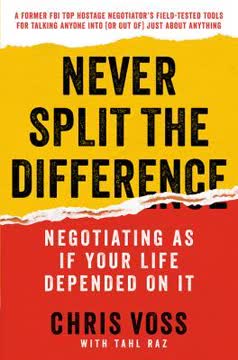
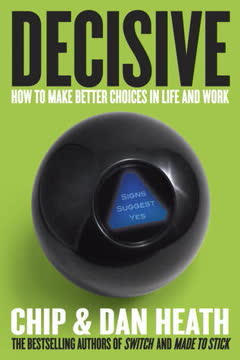
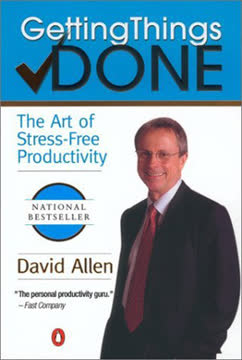
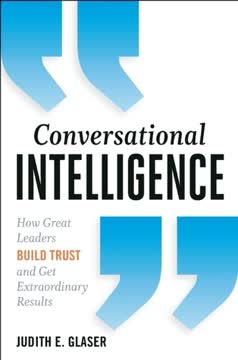
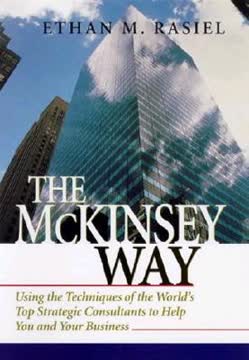
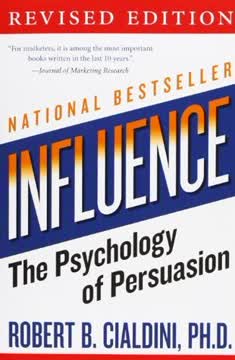

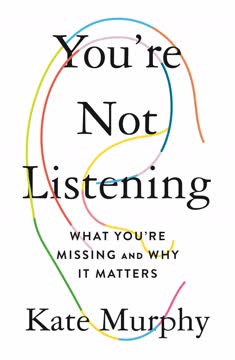
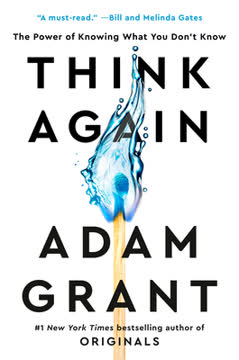
Download PDF
Download EPUB
.epub digital book format is ideal for reading ebooks on phones, tablets, and e-readers.
